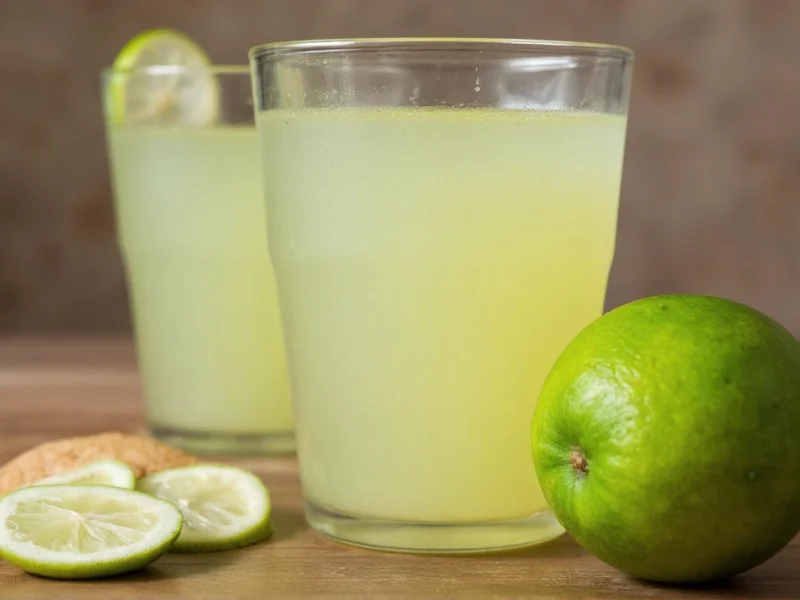When substituting lime juice concentrate for fresh lime in your recipes, understanding the precise conversion ratio is essential for achieving the perfect flavor balance. Many home cooks and professional chefs face this question when fresh limes aren't available or when working with recipes that specify concentrate.
Understanding Lime Juice Concentrate vs. Fresh Lime Juice
Lime juice concentrate undergoes a process where water is removed from fresh lime juice, creating a more potent product that's easier to store and transport. This concentration process means you need less volume of concentrate to achieve the same tartness as fresh lime juice.
The standard conversion ratio accepted by most culinary professionals is:
| Lime Juice Type | Equivalent Measurement | Acidity Level |
|---|---|---|
| 1 fresh lime | 2 tablespoons (30ml) juice | Natural acidity (6-8%) |
| Lime juice concentrate | 2 tablespoons (30ml) | Higher acidity (10-12%) |
| Reconstituted concentrate | 4 tablespoons (60ml) with water | Approximates fresh lime |
Factors Affecting the Conversion Ratio
Several variables can influence how much lime juice concentrate equals one lime:
- Brand differences: Some brands use different concentration methods, affecting potency
- Freshness of limes: A large, juicy lime may yield up to 3 tablespoons, while smaller limes may only produce 1.5
- Concentrate formulation: Some concentrates include additives that affect flavor intensity
- Storage conditions: Older concentrate may lose some potency over time
Practical Substitution Guidelines
When replacing fresh lime with concentrate in recipes, follow these professional kitchen recommendations:
- For most standard recipes, use 2 tablespoons of concentrate per lime called for
- When making cocktails or delicate dishes, start with 1.5 tablespoons and adjust to taste
- For baking recipes where acidity affects chemical reactions, maintain the 2:1 ratio precisely
- Always add concentrate gradually, tasting as you go, especially in sensitive recipes
When to Choose Concentrate Over Fresh Lime
Lime juice concentrate offers several advantages in specific cooking scenarios:
- Consistent flavor: Concentrate provides uniform tartness regardless of season
- Extended shelf life: Properly stored concentrate lasts months versus days for fresh juice
- Convenience factor: Ideal for commercial kitchens needing precise measurements
- Cost efficiency: Often more economical when fresh limes are out of season
However, fresh lime juice generally provides superior flavor complexity and aroma that concentrate cannot fully replicate, making it preferable for dishes where lime flavor is the star component.
Tips for Best Results with Lime Juice Concentrate
Maximize your cooking success with these professional tips:
- Chill concentrate before using to better approximate fresh lime temperature
- Add a tiny pinch of salt to concentrate to enhance lime flavor perception
- For recipes calling for lime zest, you'll still need fresh limes as concentrate lacks oils
- When substituting in ceviche or other "cooked" dishes, use slightly less concentrate
- Store opened concentrate in glass rather than plastic containers to prevent flavor absorption
Common Mistakes to Avoid
Many home cooks make these errors when substituting lime juice concentrate:
- Using equal volumes of concentrate and fresh lime juice without adjustment
- Not accounting for the higher acidity of concentrate in baking recipes
- Using frozen concentrate without proper thawing and mixing
- Expecting concentrate to provide the same aromatic qualities as fresh lime
- Substituting concentrate in recipes specifically designed for fresh lime zest
Measuring Lime Juice Accurately
For precise recipe results, follow these measurement techniques:
- Roll limes firmly on the counter before juicing to release more juice
- Use a citrus press for maximum yield from fresh limes
- Measure concentrate with liquid measuring spoons, not dry measures
- When in doubt, start with less concentrate and add gradually
- Consider using a kitchen scale for critical recipes (1 tablespoon = 14.8g)











 浙公网安备
33010002000092号
浙公网安备
33010002000092号 浙B2-20120091-4
浙B2-20120091-4